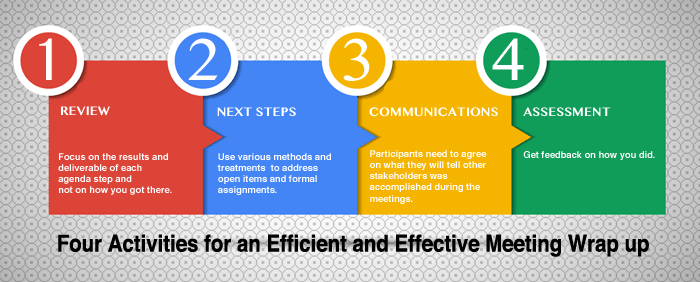Daniel Pink’s book When: The Scientific Secrets of Perfect Timing stresses the importance of the meeting wrap-up. He calls it “ending on a high note.” Others refer to the power of the recency effect. Below find four critical activities needed to facilitate clear and actionable results during your meeting wrap-up. The result from many productive meetings can be summed up with four words: “WHO DOES WHAT & WHEN.“
#1-Review, #2-Next Steps, #3-Communications, and #4-Assessment.
Do not skip any of these four activities but expand and contract your treatment of them based on your situation and constraints.
Meeting Wrap-up #1 – Review
Do not relive the session, but do review the outputs, decisions, assignments, and so on. Focus on the results and deliverables from each Agenda Step, not on how you got there. Participants do not need a transcript. They need to be reminded about significant takeaways and offered the opportunity to ask for additional information or clarification before the session ends. Be prepared to use the Definition Tool to address uncertainties or disagreements about the meaning of something.
If possible and practical, use the documentation generated during the session to structure a quick walk-through. During the walk-through, include real-life examples for participants to see how well the deliverable performs. Next, assign responsibility to “Parking Lot” items (i.e., Open Issues) that remain valid and unresolved.
Meeting Wrap-up #2 – Next Steps
Two types of action items are developed during meetings: items within the scope and required to complete the deliverable and items out of scope but too important or opportunistic to disregard.
Assignments Within the Scope of the Deliverable
During the meeting, record open issues as they arise. Various terms describe open issues that develop during meetings, most frequently called a meeting parking lot.
Have your group list the action items that they have already agreed to or will undertake—starting tomorrow. List the items, clarify them, and have someone take responsibility. Assign a deadline (month, day, year) for a status update.
Consider applying the RASI tool (Transform Your Responsibility Matrix Into a GANTT Chart) to convert your action items into a project plan. Remember, absence or silence is unacceptable during assignments. Therefore, do not permit making assignments to someone who is not attending the meeting, either live or virtually.
Assignments Out of Scope of the Deliverable
Facilitate your meeting parking lot activity after you have completed closed issues and assigned other action items that are within the scope of the deliverable. Then, review each open issue. Make sure the open issue remains valid. Over the course of meetings, some open issues are no longer “open”. If so, delete them or mark them accordingly (e.g., OBE = Overcome by Event, or taken care of).
Standard Activities for Managing a Meeting Parking Lot
Append each open issue using the following sequence:
-
- The issue is more fully defined—a complete, coherent statement of description
- Note the single individual responsible for communicating back to the group on the status of the open issue (frequently viewed as who ‘will do’ or complete the open issue)
- Expected completion or progress update (month, day, year)
- How progress or completion will be communicated to your group of participants
- If follow-up requires a file, give the file a name to make future ‘searches’ easier
- Consider email size limitations, file naming conventions, and file-server security restrictions
Alternative Methods for Managing a Meeting Parking Lot
We call a simple method for managing meeting parking lot issues a “2 by 4.” Meant to connote a standard piece of lumber, the method suggests a quick, three-question approach—namely:
- To: Do what?
- By: Who and when?
- For: What purpose or benefit?
Steve Jobs, ex-CEO of Apple Inc., called this assignment activity essential, the heart of a meeting. He called the person assigned a specific task the DRI (“Directly Responsible Individual”). For each project, and every task in that project, he wanted someone accountable. Their congratulations or blame depended on how they did.
For complex open issues, or big hairy audacious goals (BHAG) that might constitute major or multiple new products or projects and cannot simply be assigned to someone, use the Content Management Tool. Use the output from this meeting (what) as input for a future meeting when the time, place, and people are available to conduct further analysis and make appropriate decisions or assignments. In that next meeting, begin with this open issue as input by asking “So what?” or “Why do we care?
Once the next steps and assignments are clear, your meeting is nearly over, except for . . .
Meeting Wrap-up #3 – Communications
Here you lead the participants to agree on what they will tell other stakeholders was accomplished during the meeting. Additionally, you get your group to agree on how it will communicate results to others.
At a minimum, team members need an “elevator speech” that can deliver an effective synopsis of the meeting results. At the other extreme, if the meeting is strategic, there could be numerous audience types such as the investment community, suppliers, trade personnel, etc. If so, identify the key audience members before discussing the message, medium of communication, and frequency of communication for each.
When it is important that it sounds like the participants attended the same meeting together, consider agreeing on the rhetoric used to describe the meeting. Typically, the two major audiences are:
- What do we tell our bosses or superiors?
- What do we tell people dependent on our results (i.e., stakeholders)?
Take a few moments to homogenize the rhetoric and help them agree on what they will tell people who ask. More importantly, agreement on what NOT to tell others. At a minimum consider two audiences and record the bullets or sound bites for each. Separately consider, for example, participants’ superiors and other stakeholders (e.g., peers or customers). See STOP! Were We Even In The Same Meeting? for detailed instructions.
If necessary, discuss HOW TO communicate with the target audience such as face-to-face, email, etc. For complicated communications plans, further, discuss frequency or how often to set up regular communications. It may be necessary to schedule the communications so that the superiors are informed before other stakeholders. Failing to plan suggests planning to fail. Meeting participants will use separate methods and discrete rhetoric that may generate different understandings among stakeholders who are expected to share similar understandings.
Meeting Wrap-up #4 – Assessment
Get feedback on how well you did and what you can do to be better. Set up or mark a whiteboard by the exit door and create two columns, typically PLUS and DELTA (ie, the Greek symbol ∆ or “change”) but also known as OFI (Opportunity for Improvement), “Benefits & Concerns” (also known as the “B’s & C’s”), “Star/Delta”, and Appreciative (+) or Opportunistic (-). Have each participant write down on a small Post-it® note, at least one thing they liked about the meeting (+) and one thing they would change (∆). Ask them to mount each note in its respective column as they exit.
Effective leaders will not let their meetings wrap up until participants have been offered a final opportunity to comment or question, action steps have been discussed, messaging has been agreed to, and feedback for continuous improvement has been solicited. Continue to fortify your skill set with additional tools and improvement suggestions available in our Facilitation Best Practices.
One way to stir things up in meetings would be to begin calling the Parking Lot a Meeting Refrigerator. Here is why.
Other terms used by organizations include Issue Bin, Coffee Pot, Water Cooler, Elevator Speech, Limbo, Chestnuts, Popcorn, and our favorite, Refrigerator. (Refrigerator reflects a term used in the Middle East because the items temporarily stored there can be preserved and cooked up later). Regardless of the term you use, open issues need to be managed properly rather than left unassigned as a list of items without context or assigned next steps.
Changing an organizational culture provides as many challenges as you can imagine, typical of mergers and acquisitions. Without some patience, time, and more patience, most efforts fail. Meanwhile, change itself faces so much resistance that it will not happen ‘overnight.’
We can however take little stabs at calibrating, modifying, and shifting behaviors. For example, calling the Parking Lot a Meeting Refrigerator. Eventually, change occurs once it hits an inflection point.
The term Parking Lot connotes a place of rest, where no progress is made, and stuff begins to rust. Sometimes, people forget or ignore items left in the parking lot. Therefore, they might rust or accumulate a lot of dust (or snow) before we manage them.
Place items in a Meeting Refrigerator (instead of a Parking Lot) to preserve and protect them. In addition, some things we take out of a Meeting Refrigerator can be re-cooked to provide an entire meal(s), where our business meals are frequently called projects. So call the ‘Parking Lot’ a Meeting Refrigerator because your open items are worth preserving and protecting, rather than ignoring.
______
Don’t ruin your career by hosting bad meetings. Sign up for a workshop or send this to someone who should. MGRUSH workshops focus on meeting design and practice. Each person practices tools, methods, and activities every day during the week. Therefore, while some call this immersion, we call it the road to building high-value facilitation skills.
Our workshops also provide a superb way to earn up to 40 SEUs from the Scrum Alliance, 40 CDUs from IIBA, 40 Continuous Learning Points (CLPs) based on Federal Acquisition Certification Continuous Professional Learning Requirements using Training and Education activities, 40 Professional Development Units (PDUs) from SAVE International, as well as 4.0 CEUs for other professions. (See workshop and Reference Manual descriptions for details.)
Want a free 10-minute break timer? Sign up for our once-monthly newsletter HERE and receive a timer along with four other of our favorite facilitation tools, free.

Terrence Metz, MBA, CSM, CSPF, PSP01, HTTO1, is the Managing Director of MG RUSH Facilitation Leadership, Training, and Meeting Design, an acknowledged leader in structured facilitation training, and author of “Meetings That Get Results – A Facilitator’s Guide to Building Better Meetings.” His FAST Facilitation Best Practices blog features nearly 300 articles on facilitation skills and tools aimed at helping others lead meetings that produce clear and actionable results. His clients include Agilists, Scrum teams, program and project managers, senior officers, and the business analyst community among numerous private and public companies and global corporations. As an undergraduate of Northwestern University (Evanston, IL) and an MBA graduate from NWU’s Kellogg School of Management, his professional experience has focused on process improvement and product development. He continually aspires to make it easier for others to succeed.






That’s interesting! I have been browsing for this evidence for quite a long time.
Our thanks for your feedback Bower.
Nice post!
Thanks Fredro,
Lot’s of other proven tools and training for better meetings can be found at https://mgrush.com/blog/
Terrence